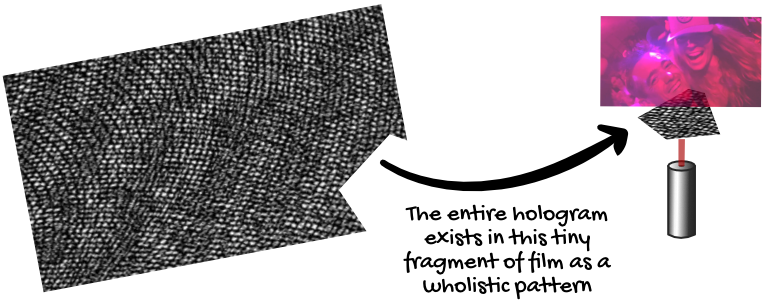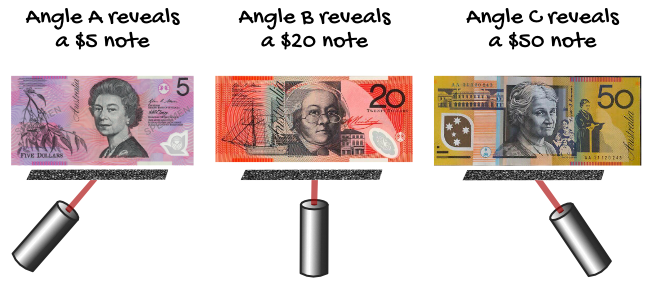"Okay, so the first relevant holographic property is that three-dimensional information is stored in a lower-dimensional format. The second property is non-locality — that at the lower-dimensional level of the holographic film, physical location ceases to exist, and everything is everywhere. Separation is an illusion. This then segues into the next holographic property, which is one of the most relevant to us."
"What is it?" Zac asked.
"Every portion of a hologram contains the image of the whole. So—" I picked up the remaining fragment of paper "—if I were to cut this piece of holographic film up into teeny tiny pieces, and then shine a laser through each piece, each piece of the film would contain the entire image of Ned and me."
I ripped up the paper into ten pieces and then shone my phone's torchlight through each fragment.

"This one, and this one, and this one. All of them contain Ned and myself. Every part contains the whole. It's like that beautiful William Blake poem..."
To see a World in a Grain of Sand
And a Heaven in a Wild Flower,
Hold Infinity in the palm of your hand
And Eternity in an hour.
William Blake
Zac grinned. "That is magical."
"I know!" I replied. "So when I refer to holographic patterns or holographic algorithms, I'm talking about this property. You can subdivide the whole into smaller and smaller fragments of different shapes and sizes, and you'll find the same pattern at all different levels, in all different fragments. It's a beautiful form of symmetry."
"Pretty schweet. I love it."
"Now for the last relevant holographic property: everything all exists at once."
"Is this explaining time?" Zac asked.
"Yes," I said. "Well, it's a metaphor for time. Actually, I never really told you how holograms are created in the first place. I won't go into too much detail. For our purposes, one type of hologram is created by bouncing two lasers off an object at different angles and recording the interference pattern of light on the holographic film."
"Didn't you mention interference patterns when you talked about the double-slit experiment?" Zac asked.
"Very perceptive, yet again, Mister Borrowdale. The disordered pattern recorded on a holographic piece of film is actually an interference pattern. When you shine a laser at the pattern at the same angle that initially created it, the three-dimensional holographic illusion will unfold as the light interacts with the pattern. But the exciting thing is that you can encode vast amounts of information in a single piece of holographic film. Actually, do you have any cash?"
"Yes…" Zac said. "But I'm not giving it to you."
"No, I just need some different notes."
"I have a $5, $20, and $50 note." He hesitantly handed them over.
"Okay," I continued. "Let's say we create a hologram of this $5 note. We bounce the lasers off the note, and the interference pattern of light is recorded on the holographic film. And let's say we position our primary laser at angle A.
Now let's do the same thing for the $20 note, but we'll position the laser at angle B and record the interference pattern on the same holographic film. Then we'll do the same for the $50 note, but we'll position the laser at angle C.
Now that we've made our holograms, this single two-dimensional sheet of holographic film contains all the information representing those three notes. This method of information storage is so efficient that theoretically you could store fifty bibles worth of information on a one-inch-square piece of holographic film."
"Woah!" Zac said. "That's incredible!"
"I know! But here's the cooler part: if I want a particular note to unfold from the holographic film, I just need to shine my laser through the film at the same angle that created it. So, if I shine the laser through at angle A, the $5 note will appear. But then if I shift the laser to angle B, the $20 note will appear. If I shift the laser to angle C, the $50 note will appear.

"It's important to realize that the $5, $20, and $50 notes all exist simultaneously. They are all encoded in the lower dimension of the holographic film. Depending on the angle of the laser, a different note will emerge from the film. In that way, time is an illusion. If you want to create a moving hologram, a single piece of film can encode all the still frames of the hologram. As you shine the laser through at different angles, different images will appear to create the illusion of time."
"Hmm..." Zac said. "Let's say I currently have five dollars in my bank account. If reality is functioning on holographic principles, do I also have twenty dollars and fifty dollars in my bank account right now, but I just don't perceive those possibilities?"
"Yes," I replied. "Anything that has happened, is happening or could happen is all happening right now, but we only perceive one possibility at a time. In the Schrödinger's cat example, the cat is both alive and dead in the lower dimension of the holographic film. In the money example, there are also scenarios where you have a thousand dollars, or a million dollars, or a billion dollars in your bank account. It's similar to how all possibilities simultaneously exist in the lower-dimensional codebase of a game."
"So how do I 'light up' the billion-dollar scenario?" Zac asked.
"You're getting ahead of yourself," I giggled. "I'm trying to keep this explanation as rational and linear as possible so we can deduce the answer from first principles."
"But there is an answer, right? You're not making me sit through this long-winded intellectual adventure, only to tell me that I have no more control over my reality than what I previously thought, are you?"
"Zac," I sighed, "believe me — when I explain this beautiful algorithm, all will be revealed. You will realize that we all have far more control over our reality than mainstream science has been telling us all these years, and we don't need to believe in mystical Gods or spirits to come to that conclusion. We just need to believe in our ability to ask good questions, think critically, and assess empirical evidence without bias and preconceived notions. Oh, and math. We need to believe in math."
Zac leaned forward in excitement. "So when do I get to learn the answer?"
"After I explain how to torture an AI superintelligence."
"Err… what the fuck does that have to do with all this?" He leaned back, his brow furrowed in confusion.

